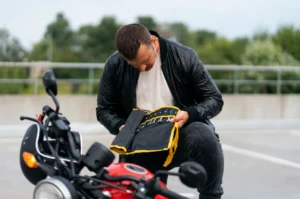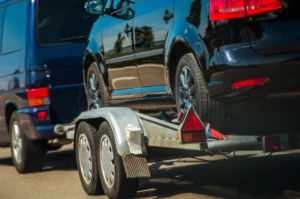Your motorcycle is something you saved up for, so when it breaks down, watching someone load it onto a flatbed triggers every protective instinct you have.
The only problem is that most people don’t understand that motorcycle towing in NYC can’t be treated like cars. Your bike doesn’t have four stable wheels. It’s top-heavy, has exposed chrome and fairings, and a suspension system that wasn’t designed to stay compressed for hours.
One careless strap placement or too-steep loading ramp, and you’re looking at bent forks, cracked fairings, or a repair bill that makes you physically ill.
Whether you’re handling the tow yourself or calling professionals, knowing what actually keeps a motorcycle safe during transport is the difference between your bike arriving intact or facing thousands in damage.
Why Your Bike Can’t Be Towed Like a Car?
You already know this intuitively, but it’s worth spelling out: cars are stable. Four wheels, low center of gravity, protective body panels.
Your motorcycle has none of these advantages.
Remove yourself from the seat, and suddenly that stability disappears. The weight distribution shifts entirely. What feels planted and solid when you’re riding becomes precarious the moment you step off.
Your suspension is designed for dynamic riding, compressing and rebounding as you navigate potholes and corners. It’s not built to stay compressed under constant pressure, which is exactly what happens when someone over-tightens straps during transport. This can damage seals, mess with fork alignment, and create mechanical problems that don’t show up until weeks later.
What Equipment Should You Use?
You can’t improvise motorcycle transport. Using the wrong trailer, cheap straps, or a makeshift ramp creates risks that careful handling can’t overcome.
Flatbed Trucks
Flatbeds represent the safest way to move your bike. The flat surface eliminates tipping risk, provides solid anchor points, and keeps your motorcycle completely off the road during transport. There’s a reason professional services use them almost exclusively.
If you’re considering DIY transport, look for trailers specifically designed for motorcycles. They come with built-in wheel chocks and properly positioned tie-down points. A wheel chock keeps your front tire from rolling forward or backward. Without it, your bike shifts position and can break free from straps or tip over.
Motorcycle Carriers
Hitch-mounted carriers attach to your truck or SUV’s receiver hitch. They’re smaller than trailers and don’t need separate plates or lights in most places. Good ones have anti-tilt mechanisms and adjustable chocks for different tire sizes.
The critical number here is weight capacity. Most carriers handle 600-800 pounds, which works for sport bikes, standards, and mid-size cruisers. But if you’re riding a heavy touring bike or big cruiser, you might exceed this limit.
How to Secure Your Bike? (Without Damaging It)
You can have perfect equipment and still wreck your motorcycle if you don’t strap it correctly. This is where most people mess up.
Four Straps, No Exceptions
Two straps aren’t enough. Ever.
Even with a wheel chock, using only two front straps leaves your rear end free to shift and potentially tip. Only rear straps? Your front wheel moves around, defeating the whole purpose of the chock.
Four straps, two front, two rear, give you redundancy. If one strap fails (and they do), you’ve got three others holding your bike stable.
Strap Below Your Suspension
This is the mistake that kills DIY towing attempts. When you attach straps to your handlebars or triple tree, you’re strapping above your suspension. Every bump makes the suspension compress and rebound, creating movement that loosens straps or damages the system.
Instead, strap to points below where the suspension moves, the lower fork tubes near the axle, your frame rails, or through the wheels.
Tension Should Be Tight Enough, Not Too Tight
Finding the right tension takes practice. Too loose and your bike shifts during transport. Too tight and you compress the suspension beyond its design limits, potentially damaging seals or alignment.
The rule: straps should be snug enough that you can’t manually rock the bike side-to-side, but not so tight that your forks are visibly compressed more than an inch or two.
Soft Loops Save Your Paint Job
Metal strap hooks scratching painted surfaces, chrome, or bodywork is entirely preventable. Soft loops, fabric wraps that go around your attachment point, create a buffer between metal hardware and your bike’s finish. They cost maybe twenty bucks and prevent hundreds of dollars in damage.
Also Read: How Much Does a Towing Service Cost?
How to Load Your Motorcycle?
More accidents happen during loading and unloading than during the actual drive. You’re managing hundreds of pounds of top-heavy machinery on an incline, often without being able to sit on the bike for stability.
The Loading Process
Park on level ground. Loading onto a trailer that’s on an incline adds unnecessary danger. Once positioned, extend your ramp fully and make absolutely sure it’s secured at both the vehicle and ground ends.
Put your bike in first gear before loading. This gives you mild resistance through the transmission, providing better control as you walk it up. Some people ride their bike up slowly while feathering the clutch, but this takes real skill. Walking alongside while controlling the front brake is safer for most riders.
Get help if you can. One person can’t safely control a motorcycle on a ramp if something goes sideways. A second person can help manage weight, prevent tipping, and provide emergency backup if you lose balance.
The Unloading Process
Unloading is actually more dangerous because gravity’s working against you. As your bike descends the ramp, its weight wants to accelerate downward. You need complete control of that front brake.
Before releasing any straps, make sure your bike’s in first gear. As you remove straps, work systematically, never strip all straps from one end before touching the other. Keep your bike balanced throughout.
Your Bike Deserves Better Than Guesswork
The last thing you want is to damage your motorcycle from a preventable towing mistake.
A1 Towing & Collision offers professional motorcycle towing in NYC. We handle everything from sport bikes to heavy cruisers, and we carry comprehensive insurance for complete peace of mind.
When your motorcycle needs transport, trust professionals who do this daily. Contact us for reliable, safe motorcycle towing throughout NYC!





